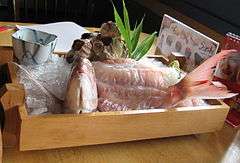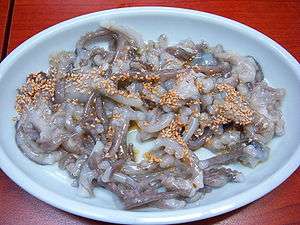Eating live seafood
The practice of eating live seafood, such as fish, crab, oysters, baby shrimp, or baby octopus, is widespread. In India, the government provides support for an annual fish medicine festival in Hyderabad, where asthma patients are given a live sardine to eat which is supposed to cure their asthma.[1] Infection by the fish tapeworm Diphyllobothrium latum is seen in countries where people eat raw or undercooked fish, such as some countries in Asia, Eastern Europe, Scandinavia, Africa, and North and South America.[2]

Oysters are typically eaten live.[3] The view that oysters are acceptable to eat, even by strict ethical criteria, has notably been propounded in the seminal 1975 text Animal Liberation, by philosopher Peter Singer. However, subsequent editions have reversed this position (advocating against eating oysters). Singer has stated that he has "gone back and forth on this over the years", and as of 2010 states that "while you could give them the benefit of the doubt, you could also say that unless some new evidence of a capacity for pain emerges, the doubt is so slight that there is no good reason for avoiding eating sustainably produced oysters".[4]
Live seafood dishes
| Location | Name | Image | Description | Video |
|---|---|---|---|---|
| China | Drunken shrimp |  |
Drunken shrimp is a popular dish in parts of China. It is based on fresh-water shrimp that are placed in a strong liquor, baijiu, and then eaten, often while they are alive. Modified recipes are used in different parts of China. For example, the drunken shrimp can be cooked in boiling water instead of serving them while they are still live. In other recipes, the shrimp are boiled first and then marinated in alcohol.[5] | Drunken Shrimp on YouTube |
| Yin Yang fish | Yin Yang fish, or dead-and-alive fish, originated in Taiwan. It is a dish which consists of a deep-fried whole fish (usually carp) that remains alive after cooking. The fish's body is cooked while its head is wrapped in a wet cloth to keep it breathing. The fish is then covered in sauce and served live on a plate.[6] Some chefs say they prepare the fish this way to demonstrate its freshness to the customer.[7][8][9][7] Preparation of this dish is now prohibited in Taiwan and illegal in Australia and Germany. | Eating A Deep Fried Fish That's Still Alive – Huffington Post | ||
| Japan | Ikizukuri |  |
Ikizukuri, lit. "prepared alive", is the preparation of sashimi made from live seafood. Fish is usually used, but sometimes octopus, shrimp and lobster are used instead.[10] The practice is controversial, and ikizukuri is outlawed in Australia and Germany.[10] | |
| Odori ebi |  |
Odori ebi, lit. "dancing shrimp", is a sashimi delicacy in Japan. It includes live baby pink shrimp, usually dunked in sake, wriggling their legs and waving their antenna as they are eaten. The meal is prepared rapidly and quickly served to ensure the shrimp are still alive. Dancing shrimp are also eaten in Thailand, where they are known as Goong Ten, กุ้งเต้น. | Eating live "dancing shrimp" in Thailand on YouTube | |
| Korea | San-nakji |  |
Sannakji is a type of hoe, or raw dish, in Korea. It consists of usually dead but seemingly alive Octopus minor (nakji, sometimes translated as "baby octopus" due to the species' small size), cut into small pieces and immediately served, with a light sesame oil seasoning. The dish is eaten while the pieces are still squirming on the plate.[11] | Eating Live Octopus in Korea – Sannakji on YouTube |
| Widespread | Live oyster |  |
Oysters are often eaten live.[12] | |
| Live lobster |  |
Restaurants in New York City serve live lobster, advertising that they allow customers the opportunity to “pick belly sashimi out of its still moving body”.[13] | I eat a live lobster in Japan on YouTube |
Controversy
Octopuses are eaten alive in several countries around the world, including the USA.[14][15] Animal welfare groups have objected to this practice on the basis that octopuses can experience pain.[16] In support of this, since September 2010, octopuses being used for scientific purposes in the EU are protected by EU Directive 2010/63/EU "as there is scientific evidence of their ability to experience pain, suffering, distress and lasting harm."[17] In the UK, this means that octopuses used for scientific purposes must be killed humanely, according to prescribed methods (known as "Schedule 1 methods of euthanasia").[18]
London resident Louis Cole runs a YouTube channel in which he eats live seafood.[19] The Guardian commented on the ethical issues raised by the behaviour of Coles that: "It seems objectively less cruel to kill a scorpion instantly than to rear chickens in battery cages or pigs in the most miserable pork farms.[19]
Health issues
In India, the government provides support for an annual fish medicine festival in Hyderabad, where asthma patients are given a live sardine to eat which is supposed to cure their asthma.[20]
Infection by the fish tapeworm Diphyllobothrium latum is seen in countries where people eat raw or undercooked fish, such as some countries in Asia, Eastern Europe, Scandinavia, Africa, and North and South America.[21]
See also
- Eating live animals
- Eating raw fish
- Ethics of eating meat
- Monkey brains (cuisine)
- Odorigui, Japanese term for consumption of live seafood while it is still moving
- Pain in crustaceans
- Pain in fish
- Pain in invertebrates
References
- Indians eat live sardines to cure asthma The Telegraph, 20 May 2012.
- U.S. National Library of Medicine, Medline Plus, "Fish Tapeworm," .
- Kurlansky, Mark (2009) The Big Oyster: A Molluscular History of New York Random House. ISBN 9781409077930.
- Cox, Christopher (April 7, 2010). "Consider the Oyster: Why even strict vegans should feel comfortable eating oysters by the boatload". Slate. Archived from the original on April 10, 2010. Retrieved 2010-04-12.
- 醉蝦 Archived August 17, 2011, at the Wayback Machine
- "Chinese diners eat live fish in YouTube video". Telegraph.co.uk. 18 November 2009. Archived from the original on 10 July 2015. Retrieved 26 July 2015.
- Nguyen, ThienVinh (18 March 2010). "Eating A Deep Fried Fish That's Still Alive (VIDEO)". Archived from the original on 4 September 2017. Retrieved 27 April 2018 – via Huff Post.
- Leach, Ben (18 November 2009). "Chinese diners eat live fish in YouTube video". The Daily Telegraph. London. Archived from the original on 9 January 2018.
- http://www.islandcrisis.net/2009/11/fried-living-fish/ Archived 2012-02-20 at the Wayback Machine (defunct 28 June 2015)
- "The Times & The Sunday Times". thetimes.co.uk. Retrieved 27 April 2018.
- South Korean fishermen, health officials tangle over octopus Archived 2013-03-19 at the Wayback Machine Loa Angeles Times, 29 October 2010.
- Kurlansky, Mark (2009) The Big Oyster: A Molluscular History of New York Archived 2015-05-19 at the Wayback Machine Random House. ISBN 9781409077930.
- Corn, L. (2011). "Eating live lobsters: Painful or delicious?". Archived from the original on March 10, 2011. Retrieved January 5, 2012.
- Eriksen, L. (November 10, 2010). "Live and let dine". The Guardian. Archived from the original on September 6, 2015. Retrieved April 15, 2015.
- Killingsworth, S. (October 3, 2014). "Why not eat octopus?". The New Yorker. Archived from the original on April 10, 2016. Retrieved April 15, 2016.
- Ferrier, M. (May 30, 2010). "Macho foodies in New York develop a taste for notoriety". Archived from the original on March 19, 2016. Retrieved April 15, 2016.
- "Animals used for scientific purposes". European Commission. Retrieved April 15, 2016.
- "The Animals (Scientific Procedures) Act 1986 Amendment Regulations 2012". Archived from the original on February 11, 2016. Retrieved April 15, 2016.
- The man who eats live animals Archived 2014-01-06 at the Wayback Machine The Guardian, 17 April 2012.
- Indians eat live sardines to cure asthma Archived 2015-09-25 at the Wayback Machine The Telegraph, 20 May 2012.
- U.S. National Library of Medicine, Medline Plus, "Fish Tapeworm," "Archived copy". Archived from the original on 2012-09-16. Retrieved 2012-09-18.CS1 maint: archived copy as title (link).
External links
- Macho foodies in New York develop a taste for notoriety The Observer, Sunday 30 May 2010.
- Foods to Try Before You Die Fox News, 19 October 2009.
- Lobsters and Crabs Feel Pain, Study Shows Discovery News, 27 March 2009.
- Do fish feel pain? HowStuffWorks. Retrieved 27 May 2012.
